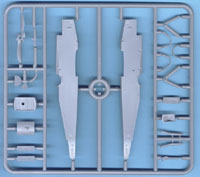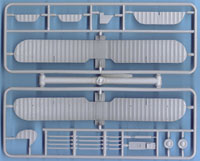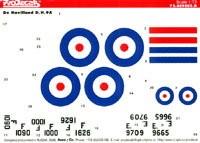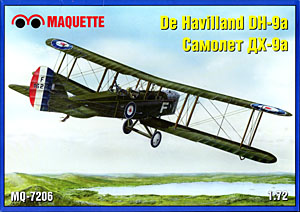Maquette's 1/72
de Havilland DH-9A | | History In marked contrast with its predecessor, the underpowered DH-9, the DH-9A was one of the RAF's outstanding aircraft, with a long service record. The need for a replacement for the DH-9 was obvious soon after its introduction, but the shortage of suitable engines made a solution difficult. In August 1917, the United States announced its new Liberty engine, describing it as "the best aircraft engine produced in any country", although it had not flown at that time. An ambitious production program was planned and Britain ordered 3,000 Liberties, for use in an improved two-seat day-bomber based on the DH-9. Inevitably, the Liberty engine had its share of development problems, and over 1,000 modifications were made between September 1917 and February 1918. After a time, however, the Liberty proved as reliable as any engine of the period. Armament of the DH-9A consisted of one forward-firing fixed Vickers machine-gun, mounted in front and to the left of the pilot. The observer, in the rear cockpit, had either one or two Lewis machine guns mounted in a Scarff ring. Bomb load was maxed out at 600lbs, commonly set up with two 230lb bombs. This proved to be about double the load the DH-9 could carry, and the DH-9A could carry it to altitude with no loss of performance. By the end of 1918 nearly 1,000 DH-9As had been built, and the plane went on to serve for many years after WWI, including in the Soviet Union under the designation R-1.  The Kit The Kit Compared to the only other model of the DH-9A that I've seen, I can say that this one is really quite poor. Then again, that other DH-9A happens to be John Alcorn's stupendous scratchbuilt 1/24 DH-9A, next to which ANY model in a box would look poor! Seriously, though, this kit is well-molded in a light gray plastic with hardly any flash present. The parts breakdown is fairly straightforward, although the interesting shapes around the nose required some odd engineering. The interior is one of two weak points on this kit, as there is very little included. There's little more than a floor, a generic seat, and a simple instrument panel. There's no sidewall detail molded into the fuselage halves either, resulting in a very basic look. On the plus side, there's nothing that you need to remove in superdetailing this kit. The other negative of this kit is with the flying surfaces. The wings and tailplanes both suffer from some heavily over-accentuated rib structures which will require a combination of filling the troughs and knocking off the high spots. The undersides of the wings have no detail molded into them, so at least that area is more salvageable  than the rest. For the tailplanes it might be easier to scratchbuild new items, using the kit parts as templates. One plus in the empennage area is that both the rudder and elevators are molded separately, allowing for simple repositioning. than the rest. For the tailplanes it might be easier to scratchbuild new items, using the kit parts as templates. One plus in the empennage area is that both the rudder and elevators are molded separately, allowing for simple repositioning. The rest of the kit is made up of detail parts, mainly the struts. These are fairly well done, although the wing struts could do with some thinning. The landing gear struts are well done, though, with a nice airfoil shape to them. The prop is also nicely done, with leading edge detailing and a separate shaft & prop boss. The only other thing that I'd want to replace with aftermarket items in this kit would be the guns, simply because no injection machine gun can compare to a resin and/or etched brass example. The decals for this kit are a big shining spot, being exceptionally well printed and in perfect register. Although most of the decal sheet subject matter is white, the roundels have very good color. Given the outstanding registration on the roundels, I  was surprised that the rudder stripes were printed separately, but this too is a good idea. There are no less than six options included on this sheet, all RAF examples finished in PC10 and CDL, with gray noses. The options are listed as: was surprised that the rudder stripes were printed separately, but this too is a good idea. There are no less than six options included on this sheet, all RAF examples finished in PC10 and CDL, with gray noses. The options are listed as: No. 205 Squadron, France 1919
No. 110 Squadron, France, August 31, 1918 (First DH-9A Squadron)
No. 99 Squadron, France, December 1918
British Expeditionary Force, Great Britain, February 1919
No. 10 Training Depot Station, Great Britain, September 1918
No. 552 Flight of No. 221 Squadron, Expeditionary Force in Russia (eventually captured by the Red Army and became the prototype for the R-1) Conclusion This kit may not build up out of the box to match a scratchbuilt DH-9A, but with a little work it will make into a nice example of the Nine-ack The beautiful decal sheet provides plenty of nice options and the kit is worth it for that alone. If you're looking for a nice project model and want something British, pick this kit up. I bought this kit from Skyway Hobby Shop in Seattle. Excellent selection and good prices. | 


 




    |
